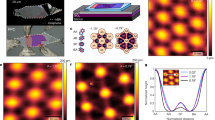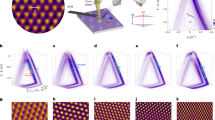Abstract
Peculiar electron–phonon interaction characteristics underpin the ultrahigh mobility1, electron hydrodynamics2,3,4, superconductivity5 and superfluidity6,7 observed in graphene heterostructures. The Lorenz ratio between the electronic thermal conductivity and the product of the electrical conductivity and temperature provides insight into electron–phonon interactions that is inaccessible to past graphene measurements. Here we show an unusual Lorenz ratio peak in degenerate graphene near 60 kelvin and decreased peak magnitude with increased mobility. When combined with ab initio calculations of the many-body electron–phonon self-energy and analytical models, this experimental observation reveals that broken reflection symmetry in graphene heterostructures can relax a restrictive selection rule8,9 to allow quasielastic electron coupling with an odd number of flexural phonons, contributing to the increase of the Lorenz ratio towards the Sommerfeld limit at an intermediate temperature sandwiched between the low-temperature hydrodynamic regime and the inelastic electron–phonon scattering regime above 120 kelvin. In contrast to past practices of neglecting the contributions of flexural phonons to transport in two-dimensional materials, this work suggests that tunable electron–flexural phonon coupling can provide a handle to control quantum matter at the atomic scale, such as in magic-angle twisted bilayer graphene10 where low-energy excitations may mediate Cooper pairing of flat-band electrons11,12.
This is a preview of subscription content, access via your institution
Access options
Access Nature and 54 other Nature Portfolio journals
Get Nature+, our best-value online-access subscription
$29.99 / 30 days
cancel any time
Subscribe to this journal
Receive 51 print issues and online access
$199.00 per year
only $3.90 per issue
Buy this article
- Purchase on Springer Link
- Instant access to full article PDF
Prices may be subject to local taxes which are calculated during checkout




Similar content being viewed by others
Data availability
Source data are provided with this paper.
References
Dean, C. R. et al. Boron nitride substrates for high-quality graphene electronics. Nat. Nanotechnol. 5, 722–726 (2010).
Bandurin, D. A. et al. Negative local resistance caused by viscous electron backflow in graphene. Science 351, 1055–1058 (2016).
Crossno, J. et al. Observation of the Dirac fluid and the breakdown of the Wiedemann–Franz law in graphene. Science 351, 1058–1061 (2016).
Krishna Kumar, R. et al. Superballistic flow of viscous electron fluid through graphene constrictions. Nat. Phys. 13, 1182–1185 (2017).
Cao, Y. et al. Unconventional superconductivity in magic-angle graphene superlattices. Nature 556, 43–50 (2018).
Liu, X., Watanabe, K., Taniguchi, T., Halperin, B. I. & Kim, P. Quantum Hall drag of exciton condensate in graphene. Nat. Phys. 13, 746–750 (2017).
Li, J. I. A., Taniguchi, T., Watanabe, K., Hone, J. & Dean, C. R. Excitonic superfluid phase in double bilayer graphene. Nat. Phys. 13, 751–755 (2017).
Mariani, E. & von Oppen, F. Flexural phonons in free-standing graphene. Phys. Rev. Lett. 100, 076801 (2008).
Castro, E. V. et al. Limits on charge carrier mobility in suspended graphene due to flexural phonons. Phys. Rev. Lett. 105, 266601 (2010).
Bistritzer, R. & MacDonald, A. H. Moiré bands in twisted double-layer graphene. Proc. Natl Acad. Sci. USA 108, 12233–12237 (2011).
Wu, F., MacDonald, A. H. & Martin, I. Theory of phonon-mediated superconductivity in twisted bilayer graphene. Phys. Rev. Lett. 121, 257001 (2018).
Lian, B., Wang, Z. & Bernevig, B. A. Twisted bilayer graphene: a phonon-driven superconductor. Phys. Rev. Lett. 122, 257002 (2019).
Polshyn, H. et al. Large linear-in-temperature resistivity in twisted bilayer graphene. Nat. Phys. 15, 1011–1016 (2019).
Kim, T. Y., Park, C.-H. & Marzari, N. The electronic thermal conductivity of graphene. Nano Lett. 16, 2439–2443 (2016).
Principi, A. & Vignale, G. Violation of the Wiedemann–Franz Law in hydrodynamic electron liquids. Phys. Rev. Lett. 115, 056603 (2015).
Müller, M., Fritz, L. & Sachdev, S. Quantum-critical relativistic magnetotransport in graphene. Phys. Rev. B 78, 115406 (2008).
Yiğen, S. & Champagne, A. R. Wiedemann–Franz relation and thermal-transistor effect in suspended graphene. Nano Lett. 14, 289–293 (2014).
Waissman, J. et al. Electronic thermal transport measurement in low-dimensional materials with graphene non-local noise thermometry. Nat. Nanotechnol.17,166–173 (2022)
Sadeghi, M. M., Jo, I. & Shi, L. Phonon-interface scattering in multilayer graphene on an amorphous support. Proc. Natl Acad. Sci. USA 110, 16321–16326 (2013).
Zarenia, M., Principi, A. & Vignale, G. Disorder-enabled hydrodynamics of charge and heat transport in monolayer graphene. 2D Mater. 6, 035024 (2019).
Liao, B. et al. Significant reduction of lattice thermal conductivity by the electron–phonon interaction in silicon with high carrier concentrations: a first-principles study. Phys. Rev. Lett. 114, 115901 (2015).
Vu, D. et al. Thermal chiral anomaly in the magnetic-field-induced ideal Weyl phase of Bi1−xSbx. Nat. Mater. 20, 1525–1531 (2021).
Yang, X. et al. Indirect electron–phonon interaction leading to significant reduction of thermal conductivity in graphene. Mater. Today Phys. 18, 100315 (2021).
Yang, X., Liu, Z., Meng, F. & Li, W. Tuning the phonon transport in bilayer graphene to an anomalous regime dominated by electron–phonon scattering. Phys. Rev. B 104, L100306 (2021).
Jaoui, A. et al. Departure from the Wiedemann–Franz law in WP2 driven by mismatch in T-square resistivity prefactors. npj Quantum Mater. 3, 64 (2018).
Yao, M., Zebarjadi, M. & Opeil, C. P. Experimental determination of phonon thermal conductivity and Lorenz ratio of single crystal metals: Al, Cu, and Zn. J. Appl. Phys. 122, 135111 (2017).
Poncé, S., Margine, E. R., Verdi, C. & Giustino, F. EPW: electron–phonon coupling, transport and superconducting properties using maximally localized Wannier functions. Comput. Phys. Commun. 209, 116–133 (2016).
Zakharchenko, K. V., Roldán, R., Fasolino, A. & Katsnelson, M. I. Self-consistent screening approximation for flexible membranes: application to graphene. Phys. Rev. B 82, 125435 (2010).
Kuang, Y., Lindsay, L., Wang, Q. & He, L. Lattice chain theories for dynamics of acoustic flexural phonons in nonpolar nanomaterials. Phys. Rev. B 102, 144301 (2020).
Seol, J. H. et al. Two-dimensional phonon transport in supported graphene. Science 328, 213–216 (2010).
Herring, C. Theory of the thermoelectric power of semiconductors. Phys. Rev. 96, 1163–1187 (1954).
Yoshino, H. & Murata, K. Significant enhancement of electronic thermal conductivity of two-dimensional zero-gap systems by bipolar-diffusion effect. J. Phys. Soc. Jpn 84, 024601 (2015).
Lee, S., Broido, D., Esfarjani, K. & Chen, G. Hydrodynamic phonon transport in suspended graphene. Nat. Commun. 6, 6290 (2015).
Huberman, S. et al. Observation of second sound in graphite at temperatures above 100 K. Science 364, 375–379 (2019).
Kaasbjerg, K., Thygesen, K. S. & Jacobsen, K. W. Unraveling the acoustic electron–phonon interaction in graphene. Phys. Rev. B 85, 165440 (2012).
Jaoui, A. et al. Quantum critical behaviour in magic-angle twisted bilayer graphene. Nat. Phys. 18, 633–638 (2022).
Kim, K. et al. van der Waals heterostructures with high accuracy rotational alignment. Nano Lett. 16, 1989–1995 (2016).
Giannozzi, P. et al. Advanced capabilities for materials modelling with Quantum ESPRESSO. J. Phys. Condens. Matter 29, 465901 (2017).
Pizzi, G. et al. Wannier90 as a community code: new features and applications. J. Phys. Condens. Matter 32, 165902 (2020).
Perdew, J. P., Burke, K. & Ernzerhof, M. Generalized gradient approximation made simple. Phys. Rev. Lett. 77, 3865–3868 (1996).
Acknowledgements
We thank B. Fallahazad, K. Kim and Y. Wang for discussions on dry transfer of two-dimensional heterostructures. The experimental and DFT computational efforts were respectively supported by an award (DE-FG02-07ER46377) from the Physical Properties of Materials Program and an award (DE-SC0020129) from the Computational Materials Sciences Program of US Department of Energy Office of Basic Energy Science. Development of the analytical models was supported by a Multidisciplinary University Research Initiative (MURI) award (N00014-21-1-2377) from the US Office of Naval Research. Development of the heterostructure transfer technique was supported by the Army Research Office under grant no. W911NF-17-1-0312. The measurement device was fabricated at the Texas Nanofabrication Facility supported by US National Science Foundation (NSF) grant NNCI-1542159. The computation used resources of the National Energy Research Scientific Computing Center (NERSC), a US Department of Energy Office of Science User Facility located at Lawrence Berkeley National Laboratory, operated under Contract No. DE-AC02-05CH11231, and the Texas Advanced Computing Center (TACC) at The University of Texas at Austin. Growth of hBN crystals was supported by JSPS KAKENHI (Grant Numbers 19H05790, 20H00354 and 21H05233).
Author information
Authors and Affiliations
Contributions
L.S. initiated the study. M.M.S. and L.S. designed the experiment for the bottom-contacted sample. Y.H. and L.S. designed the experiment for the edge-contacted and hybrid-contacted samples. E.T. designed the 2D heterostructure transfer method. M.M.S. and Y.H. designed and fabricated the measurement devices, and conducted the measurements, data analysis and numerical simulations for the bottom-contacted and the other three samples, respectively. C.L. and F.G. carried out density functional theoretical calculations. A.H.M. and L.S. developed the analytical models. T.T. and K.W. synthesized the hBN crystals. L.S., M.M.S., Y.H., C.L., F.G., A.H.M. and E.T. wrote the paper with input from T.T. and K.W.
Corresponding author
Ethics declarations
Competing interests
The authors declare no competing interests.
Peer review
Peer review information
Nature thanks Wenzhong Bao and the other, anonymous, reviewer(s) for their contribution to the peer review of this work.
Additional information
Publisher’s note Springer Nature remains neutral with regard to jurisdictional claims in published maps and institutional affiliations.
Supplementary information
Supplementary Information
This Supplementary Information file has 4 sections: 1. Experimental Methods; 2. Theoretical Analysis; 3 Density Functional Theory (DFT) Calculations; 4. Simplified Models. There are 23 Supplementary figures, 2 Supplementary tables and additional references.
Rights and permissions
Springer Nature or its licensor (e.g. a society or other partner) holds exclusive rights to this article under a publishing agreement with the author(s) or other rightsholder(s); author self-archiving of the accepted manuscript version of this article is solely governed by the terms of such publishing agreement and applicable law.
About this article
Cite this article
Sadeghi, M.M., Huang, Y., Lian, C. et al. Tunable electron–flexural phonon interaction in graphene heterostructures. Nature 617, 282–286 (2023). https://doi.org/10.1038/s41586-023-05879-y
Received:
Accepted:
Published:
Issue Date:
DOI: https://doi.org/10.1038/s41586-023-05879-y
Comments
By submitting a comment you agree to abide by our Terms and Community Guidelines. If you find something abusive or that does not comply with our terms or guidelines please flag it as inappropriate.



